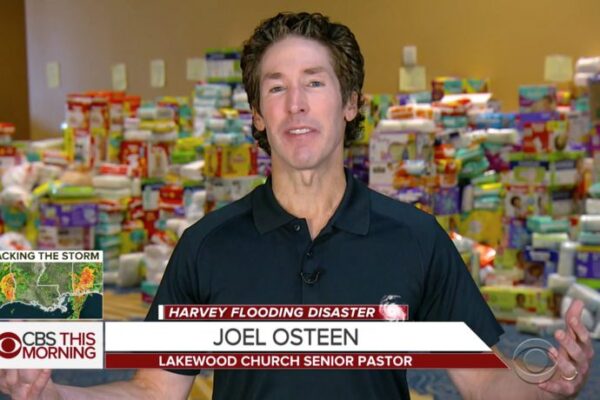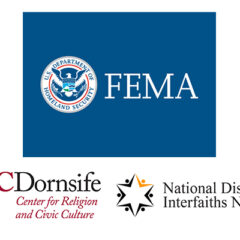This article originally appeared on Religion Dispatches.
Twitter was outraged Monday. Megachurch Pastor Joel Osteen’s Lakewood Church, housed in a former basketball arena, looked to be dry and quiet, even as thousands of Houstonians were seeking shelter from Hurricane Harvey. “Joel Osteen” started to trend on Twitter with comments about the hypocrisy of the prominent Prosperity Gospel preacher, who tweeted out that he and his wife were praying for Houston, while appearing not to do anything to address the great needs of his neighbors.
Houston's Joel Osteen has a net worth over $50m and a church that holds 16,800 but this is all he's offering. pic.twitter.com/rmhdWK6ZAO
— Mark Elliott (@markmobility) August 28, 2017
https://twitter.com/AntheaButler/status/902275796869545985
Whatever one’s opinion about Osteen, the Twitter storm above Lakewood Church perpetuated misconceptions about disaster response—namely, that all faith communities are naturally adept at it. Lakewood Church may be more typical than atypical, with organizational issues and theology getting in the way of an effective response. Congregations that do not have a strong social mission or disaster plan often flail in the wake of humanitarian disaster.
Nevertheless, many faith communities play critical roles in responding to unmet needs during and after disasters. Faith-based organizations represent the overwhelming majority of members in national and state Voluntary Organizations Active in Disaster (VOAD), associations that coordinate services across organizations. For instance, about two-thirds of the social service agencies involved in Hurricane Katrina recovery efforts were faith-based organizations, including both congregations and faith-based non-profits. Katrina revealed not only the shortcomings of federal, state and local government disaster response, but also faith-based organizations’ ability to mobilize in a time of need.
Congregations and other faith-based organizations often serve as centers of communities. They have deep local knowledge, moral capital and the trust of the people they serve, including difficult to reach minority and immigrant populations, especially vulnerable in disasters. They also have an exhaustive variety of human, material, and spatial resources—from volunteers to parking lots—that can serve as a staging ground for rescue operations. Perhaps most significantly, people of faith are moved to action by their moral framework and sense of compassion.
At the same time, the emergency management system faces challenges working with faith communities. As partners, government and faith-based organizations must identify assets, make sure people know what they are doing, and coordinate a response under a well-conceived plan. All of this has to be done long before three days into a disaster. As disaster response professionals say, a disaster site is a terrible place to exchange business cards.
Since 9/11, the emergency management community increasingly has recognized the importance of involving “whole communities” into disaster preparedness, including faith communities. The United States has a deeply religious and diverse population, with more than 70 percent identifying as an adherent of a faith. FEMA has urged emergency managers and VOAD partners to increase their religious literacy and competency to serve all Americans. To that end, thousands of emergency responders have taken a FEMA course we authored on the subject.
Making sure congregations are prepared with practical knowledge and affiliation with VOAD or emergency management is critical because even the most well-intentioned people can take counter-productive steps in an emergency situation. Even with the desire and the theological inclination to open its doors, a congregation might not have the infrastructure, organizational know-how or the personnel to serve as a shelter. In almost all cities, shelters are identified, inspected, and equipped in advance of a disaster. If faith-based volunteers tried to engage in activities beyond their competency, they could put themselves and others in harm’s way, creating a micro-disaster within a disaster.
While many Twitter commenters pointed toward Lakewood Church’s large sanctuary as a shelter, one could easily imagine a Superdome-like scenario with masses of people needing even greater assistance. On Monday, a VOAD liaison in Texas told us that Lakewood was on high ground, but largely cut off from required points of access due to floodwaters. The area has utility problems, backed-up sewers, and limited access to food delivery or medical care.
Whether genuinely moved or Twitter-shamed into action, Lakewood Church put up a page on its website lateMonday to collect donations and seek volunteers for Samaritan’s Purse, a nondenominational evangelical international relief organization that is a member of VOAD. Lakewood Church tweeted:
Coordinating with the city, Lakewood is a collection site for distributing supplies to the Houston area shelters. https://t.co/XxIbYde0L6
— Lakewood Church (@lakewoodchurch) August 29, 2017
Lakewood Church opened its doors as a shelter on Tuesday.
But being a shelter is only one way to respond to a disaster, and the larger question remains why Osteen did not have any immediate response other than tweets of prayers. It may be that Osteen’s greatest asset is his ability to raise money. But then, why is raising money the best skill of the nation’s largest single-site church?
Disaster relief and recovery work is predicated in an organization having existing skills and relationships to meet needs identified in a plan or in real time. The problem is not that Lakewood Church kept its doors closed until Tuesday, but rather that the church may not have imagined itself as a leader in times of humanitarian crisis. Or, if it had prepared for leadership, it did not share those plans in a timely manner.
When life gets hard, people often turn to religion and spirituality. To not have a call-to-action or guidance makes the whole operation feel morally bankrupt. Accurate or not, any action the church takes now looks like Osteen’s attempt to save face rather than moral leadership and conviction in the face of a crisis.
Despite its size and public image, Lakewood Church is not all that unique. Unleveraged assets exist within congregations of all faith traditions and sizes. Partnership, a plan, and training help build capacity and resilience—factors that allow congregations to act competently on their sense of compassion.
Now is the time to examine what this church, and all other congregations of all faiths, can contribute, rather than just heed the call of an angry mob that sees an asset going unused. But in the long run, Harvey presents Osteen with a wake-up call to the deficit in his moral leadership, prosperity theology and organizational practices.
Click here to read the story on Religion Dispatches.
Brie Loskota is the former executive director (2016-2021) of the USC Center for Religion and Civil Culture.
Peter Gudaitis is the president of the National Disaster Interfaiths Network (NDIN) and a guest contributor with the USC Center for Religion and Civic Culture.




